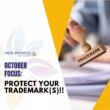As the leader of the Indie Business Network, I have the privilege of witnessing the birth of a lot of new businesses. Frequently, new Makers and Handmade Entrepreneurs find IBN because they need product liability insurance. After they join, they discover that the coaching and mentoring included with the membership are even more valuable than the insurance. After all, what good does it do to have insurance coverage for products if you don't know how to market and sell them?

Component No. 1: A Narrowly Defined Niche
Every successful handmade business that has been healthy and profitable for more than a few years has a narrowly niche. You cannot be successful if you are trying to sell every thing to every body. You cannot focus if you do that. What's worse, people cannot figure out whether you are there to serve them or whether you are just throwing spaghetti at the wall and hoping some of it sticks. In essence, a niche is the narrowly defined type of person you want to serve.
For example, our member over at The Nova Studio teaches people how to make their own bath and body products. They could also offer classes on how to make jewelry, clay pots, knitted scarves and all sorts of other things. But their niche is bath and body. Everyone knows what they do, and they have done it well for over a decade. Their laser focus has allowed them to turn The Nova Studio into a destination location where people travel from thousands of miles away to take their classes.
Another example is our member, Valerie Reid at Valana Minerals, who offers vegan mineral makeup for women of color. This business is especially notable because it is a niche within a niche within a niche. There is mineral makeup, then there's mineral makeup for women of color, then there's vegan mineral makeup for women of color. There's no question about what she sells or who she sells it to. This allows her to be efficient and effective in all of her business efforts, and it makes it easy to attract just the right women who will be primed to buy exactly what Valerie has to offer.
Component No. 2: A Specific Set of Really Well-Made and Cohesively Branded Products that Appeal to That Niche
Your products, whatever they are, have to be well-made and packaged in a way that showcases your unique brand and value proposition. Why should I buy your soap instead of someone else's? The way the product is presented has to answer that question for me without me having to make too much of an effort to answer it for myself.
For example, our member over at Adoratherapy offers aromatherapy products to help women boost their moods. You can buy blends for “creativity,” “joy,” “clarity” and “vitality.” The colors match chakras. The products are beautifully packaged, but not complicated or overdone. There are lots of bright and coordinated colors, all aimed at the “woman the go.” They started with a small line of chakra products, a niche unto itself, and then added to the line organically over time. They did not start will a million assorted products with no rhyme or reason. This allowed them to get the brand off the ground and get some money coming in the door so they could grow as the sales allowed growth to occur.
Component No. 3: An Understanding of the Regulatory Environment in Which You Operate
If you decide you want to make and sell cosmetics, for example, you must understand the FDA regulations for making, labeling and selling cosmetics. By way of example, once upon a time, it was arguably understandable for a company to make healing-type claims on cosmetics without proper testing for the simple reason that the FDA did a lousy job of educating small businesses about the requirements for making such claims. Today, that's not true. While reading FDA regulations may not be your idea of a fun date night activity, they are easy to find, and not terribly difficult to understand if you take the time to do it. If you sell products to the public, you are responsible for knowing what the regulations are and for figuring out how they apply to the products you make and sell. This is true for any regulated industry: candles, food, nutritional supplements — whatever
Familiarizing yourself with the regulations before you decide on an industry, a product line, and a niche will allow you to view the regulatory issues in advance. If you don't want to follow them, you can choose a different industry before you have invested a ton of resources.
Component No. 4: High Quality Photographs
You need good pictures if you want to sell products online. This is an obvious point, but I am continuously astounded by the number of Handmade Entrepreneurs who start businesses without good product photos.
(Making the point that good product photos are a “must” allows me an opportunity to emphasize the importance of limiting the number of products you offer, especially early in your business. If you have to invest in high quality packaging branding and product photos early in your business, you will run out of money fast if you have too many products in your line. Keep it tight and minimal to start. This allows you to control costs and maximize profits — both are imperative always, but especially early in your business.)
Whether you take them yourself or you have someone take them for you, they must invite people to feel good about forking over their hard earned cash in exchange for your stuff.
Not only do you need good product photos, but you also need good pictures of yourself. These need to be posted as avatars in your social media outlets as well as on the About page at your website. You need to have these pictures ready when bloggers or traditional media outlets ask for them. They will not wait a week for you to send them a picture. They will find someone who is ready to be featured in their story. You've got to be ready for the opportunities before they come.
Component No. 5: An Easy to Navigate Website
Remember when soapmakers had websites with bubbles that floated along behind the mouse as it moved across the screen? They were cool for customers for about 1 second, and then they were a pain in the tush. The faster people can see what you have to offer, and how to buy it at your website, the better. As you set up an easy to navigate website, remember that most sales are made before the buyer gets to the website, so once they arrive, make it easy for them to find and buy what they already saw elsewhere on your Twitter, Facebook, Instagram, etc.
A great example of an easy to navigate site is our member over at Zoe Organics. Right across the top of the home page, you can see everything you need to dive right in, including links for “About,” “Shop,” “Contact” and more. If you click “Shop,” you see every single product beautifully photographed and ready to be clicked and quickly purchased.
Our member, Brenda Foster at Bubs and Scrubs in Pennsylvania is another great example. At the top of the home page, you can choose moisturizers, soaps or gifts. Simple, and no explanation necessary. Note the nice, big, juicy product photos too. Nothing fancy, but a lot of clarity and color. (And I've used her products, they are wonderful …)
Keep it simple. If it's not simple, it's confusing. And confused people tend to leave websites. Use big, juicy pictures and simple links to help people buy.
Component No. 6: A Business Model With Supporting System
Once you know what you want to sell, you've got set up a logical system to sell it. This includes defining a specific business model and the systems to support it. In some ways, it's a business plan, which at the end of the day is simply this: how you make money.
For example, if your business model is business to business, then you are selling your handmade products to other businesses (like stores and online retailers) so they can then sell them to consumers. Your business model/plan should answer all questions about how you do that. Do you go to a spa trade shows and sell your products to spas? Or is your target business customer bed and breakfasts in the Pacitic Northwest? In that case, you find the B&B's in that area and create specific steps that allow you to get the owners to consider your products.
This is a gross oversimplification, but the bottom line is that there has to be a flow that results in an exchange of cash for the items you make. A business model can change over time. In fact, it should change as you grow, and different opportunities come your way and as the market and consumer desires change.
The basic flow of any handmade business is: Make, Market, Sell, Repeat. The details of how this is done is your business model.
Component No. 7: A Network of Supportive Coaches, Colleagues, Helpers and Friends
If you don't have a group of people around you who can support you and pick you up when you are down, celebrate with you when you are victorious, and stay up all night with you when you have to process orders during an especially busy time, you are going to be one very frustrated Maker.
Coaches and mentors hold you accountable and help you set goals and stay focused on the actions you need to take to achieve them.
Colleagues who are going through some of the same things you are can uplift and encourage you when you cannot figure out what went wrong, or if you need a new supplier for a common ingredient or packaging component.
Helpers are the virtual assistants, employees and contractors who help you pull it all together. From helping you make stuff to organizing your social media outreach, these people allow you to be everywhere and do everything without being everywhere and doing everything.
Friends are the people who want you to be happy but couldn't care less about your business because they are your friends who are there for you — business or no business.
By the way, if you're looking for a supportive network, the Indie Business Network is looking for you. You can join here.
So there you have it … The Seven Components of a Successful Handmade Business.
Best and Success!
![]()



